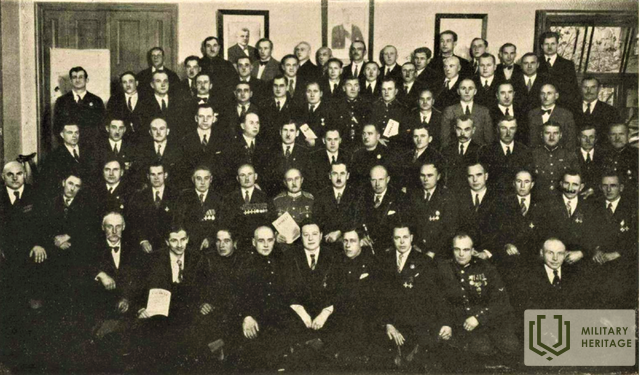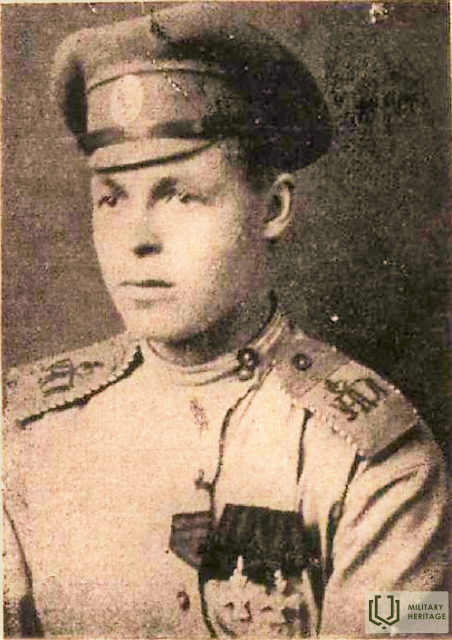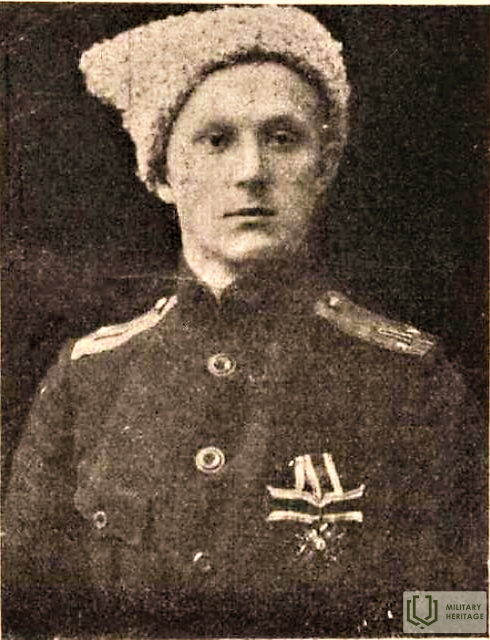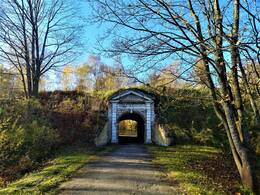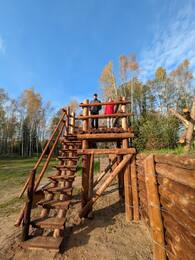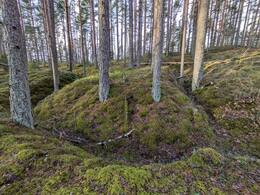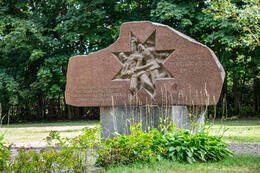1-й Даугавгривский латышский стрелковый полк
I Первая мировая война
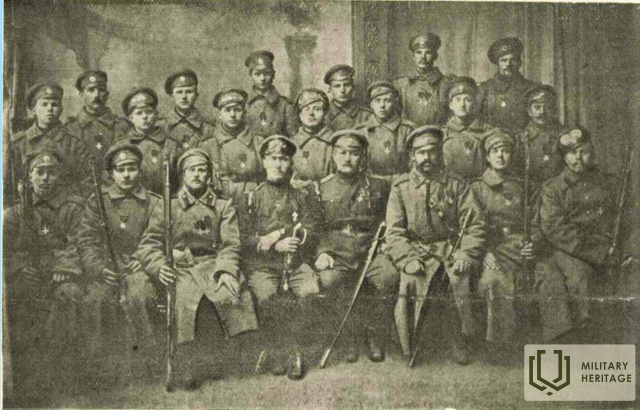
В начале Первой мировой войны латышские офицеры неоднократно обращались в вышестоящие российские военные учреждения с предложениями о создании в составе русской армии латышских национальных воинских формирований. Однако эти инициативы были отклонены. В конце 1914 года в Даугавгривской крепости были сформированы два батальона сводных трудовых рот Гвардии Даугавгривской крепости, которые с марта 1915 года участвовали в боях в Литве, а затем в Земгале и Курляндии. Успешные действия латышской гвардии в боях за оборону Елгавы в мае 1915 года вновь поставили вопрос о создании латышских национальных формирований. Осенью и зимой 1915 года оба батальона гвардии использовались в качестве кадров для формирования латышских стрелковых частей.
Формирование Национальной гвардии в Российской империи в годы Первой мировой войны осуществлялось согласно мобилизационному уставу, утверждённому в 1910 году. В Национальную гвардию призывались мужчины в возрасте от 21 до 42 лет, уволенные со службы в регулярной армии. Национальная гвардия предназначалась, прежде всего, для тылового обеспечения – охраны военно-стратегических инженерных объектов, гарнизонной службы в крепостях и городах, а также для пополнения частей регулярной армии. Подразделения Национальной гвардии часто использовались на строительстве военных объектов. Для этого формировались специальные рабочие роты даже без предоставления им вооружения.
Для нужд Даугавгривской крепости было выделено 13 рабочих рот земской гвардии. Осенью 1914 года роты земской гвардии были задействованы в основном на строительстве позиций вокруг крепости. С конца ноября 1914 года восемь вооружённых рот земской гвардии, освобождённых от строительных работ, приступили к интенсивной военной подготовке, чтобы компенсировать нехватку регулярных армейских частей.
Первый из восьми латышских стрелковых батальонов начал формироваться в августе 1915 года. Ему было присвоено название Даугавгривский. Это не случайно, ведь Даугавгривская крепость стала местом дислокации латышских частей. Из рабочих рот гарнизона крепости, в которых абсолютное большинство составляли латыши, были сформированы два батальона национальной гвардии, которые весной 1915 года приняли участие в боях с немцами в Курляндии и Северной Литве. Адъютант коменданта крепости К. Балтиньш исполнял обязанности командира первых стрелковых батальонов и работал в Комитете организации латышских стрелков.
Первые стрелковые батальоны формировались в спешке. Фронт проходил под Ригой, и немецкое наступление могло начаться в любой момент. Места для размещения стрелков не хватало, обмундирования и снаряжения не было. Оружие стрелки получили с опозданием. 1-й Даугавгривский латышский стрелковый батальон получил оружие через месяц после формирования, а обмундирование и снаряжение – ещё позже. Не хватало опытных инструкторов и офицеров. Без оружия и достаточного командного состава учебный процесс был затруднён. Это вызывало беспокойство как у стрелков, так и у офицеров. Обучение также осложнялось частыми самовольными отлучками стрелков.
В целом следует признать, что деятельность Комитета организации латышских стрелков была достойной восхищения. За короткий срок, в сложнейших условиях и без предварительного опыта было сформировано несколько боеспособных батальонов. Это был большой успех и свидетельство способности латышского общества к самоорганизации.
В ноябре 1916 года все латышские стрелковые батальоны были переименованы в полки.
Дополнительные источники информации
1. Шилиньш Я. «Латышские стрелки». Национальная энциклопедия. https://enciklopedija.lv/skirklis/31625-latviešu-strēlnieki [дата обращения: 29.10.2021].
2. Дедумиетис Д. «Батальоны сводных рабочих рот Национальной гвардии Даугавгривской крепости». Национальная энциклопедия. https://enciklopedija.lv/skirklis/58908-Daugavgrīvas-cietokšņa-zemessargu-apvienoto-darba-rotu-bataljoni [дата обращения: 29.10.2021].
3. Метель душ. Цифровой музей. Доступно: https://www.dveseluputenis.lv/lv/laika-skala/notikums/74/pirmo-latviesu-strelnieku-bataljona-formesana/ [дата обращения: 29.10.2021.].
Связанная хронология
Связанные объекты
Даугавгривская (Daugavgrīvas) крепость
Даугавгривская крепость находится на острове Даугавгрива в устье реки Бульупе в Даугаве, вход с улицы Бирзес. Крепость была построена в 17-м веке для защиты от врага направления на административный, торговый и промышленный центр – Ригу. Позже крепость стала главным укреплением береговой обороны Латвийской армии с несколькими опорными пунктами. Оборонительные укрепления и их система являются одними из самых ценных объектов военного наследия Латвии. Крепость - яркий свидетель военной истории Латвии. Например, во время Крымской войны (1853-1856 гг.) латышские и эстонские команды пушечных кораблей обучались в Даугавгривских укреплениях. Это были боевые части для защиты местных портов и побережья от атак британского военного флота. Во время Первой мировой войны здесь формировались Даугавгривские роты земессардзе - первые латвийские боевые подразделения, еще до латышских стрелков. В наши дни вы можете осмотреть территорию крепости. Рядом находится Приморский природный парк Кометфортс, а на другом берегу Даугавы - укрепления Мангальсала.
Музей Pождественских боев и выставка под открытым небом
Мемориальный парк и музей Рождественских боев находится в Валгундской волости Елгавского края, в домах «Мангали». Музей является филиалом Латвийского военного музея, он был открыт в 2005 году и находится на территории, где проходили Рождественские бои. В местах сражений до сих пор сохранились уникальные укрепления времен Первой мировой войны. В экспозиции музея представлены предметы, найденные на полях сражений.
Восстановленные укрепления можно увидеть в рамках экспозиции под открытым небом. Рядом с музеем проложены туристические маршруты и образовательные тропы. Экспозиция фортификаций и выставок времен Первой мировой войны под открытым небом открыта для посетителей каждый день. В окрестностях Ложметейкалнса сохранились уникальные свидетельства укреплений времен Первой мировой войны. Здесь находится смотровая башня высотой 27 м, с которой открывается панорамный вид на места Рождественских боев. Рождественские бои, пожалуй, самое известное и драматичное событие Первой мировой войны в Латвии. Оно занимает особое место в военной и культурной истории Латвии. Бои в основном связаны с нападением латышских стрелков на части немецкой армии, которое проходило в особо тяжелых и неблагоприятных условиях. Небывалый случай, чтобы крупномасштабная боевая операция начиналась без артиллерийской поддержки.
Нордеки – гряда дюн Калнциемас
Гряда дюн длиной около 30 км, прослеживающаяся в природе от Ильгюциемса (с небольшими перерывами) до Тирели, сегодня является одним из самых впечатляющих рельефов Приморской низменности, который редко воспринимается как единое природное образование. Дюна образовалась на берегу одного из последних Балтийских ледниковых озер, когда воды Балтийского ледникового озера отступали. Гряда дюн состоит из двух параллельных полос дюн шириной 50–100 м. Их высота обычно составляет 6–10 м, но их самые высокие точки достигают 16–19 м над уровнем моря. В окрестностях Клейсти, Иманты и Бебербеки прекрасные сосновые леса, покрывающие дюны, являются популярным местом для прогулок, отдыха и занятий спортом, а зимой – для катания на беговых лыжах. Участок дюны в районе Лачупите связан с событиями Бермонтиады. На дюне в Пардаугаве находится кладбище Лачупе или Лакарас . Между Пинки и Бабите для сохранения дюн создан природный парк Бебербеки. Западная часть дюнной гряды Нордеки-Калнциемас, протяженностью около 10 км, называется Длинной дюной . Рядом с Длинной дюной (к югу от Тренчи) находится кладбище братьев Антиньи , склад лекарств госпиталя латышских стрелков и отреставрированные землянки латышских стрелков . К югу от Длинной дюны находится массив заболоченных лесов и болот, в том числе Равайс и Мазтирелис . Напротив Мазтирелиса находится Ложметейкалнс со смотровой башней и местом отдыха и так называемым участком Немецкого вала . Ещё западнее, у Длинной дюны, находятся кладбище братьев Латышских стрелков и кладбище братьев Пики. Почти по всей гряде дюн Нордеки-Калнциемас, с большими или меньшими перерывами, тянутся окопы. В юго-западной части Длинной дюны, в примыкающих к ней с юга болотистых лесах, видны воронки от бомб времён Первой мировой войны. Вдоль всей длины Длинной дюны (к югу от неё) тянутся небольшие лесные тропинки, подходящие для прогулок и более длительных походов – прекрасная возможность осмотреть места сражений Первой мировой войны.
Памятник защитникам Елгавы
Памятник защитникам Елгавы – Даугавгривским ополченцам, остановившим наступление немецких войск на Елгаву в конце апреля 1915 года, был открыт в 1991 году рядом со школой «Свете» в Елгавском крае. В начале мая 1915 года в Елгаве прошла большая демонстрация в честь этого важного события. Тот факт, что латышским ополченцам удалось остановить наступление немцев, был использован Янисом Чаксте и его соратниками для обоснования идеи создания латышских стрелковых подразделений во время Первой мировой войны.
Автор памятника – скульптор Альвине Вейнбаха (1923–2011).
Связанные истории
О Даугавгривской крепости
Рассказчик описывает событие в Даугавгривской крепости во время Первой мировой войны, когда её бомбил немецкий армейский дирижабль. Крепость была одним из стратегических объектов, сохранивших своё значение до конца Второй мировой войны.




